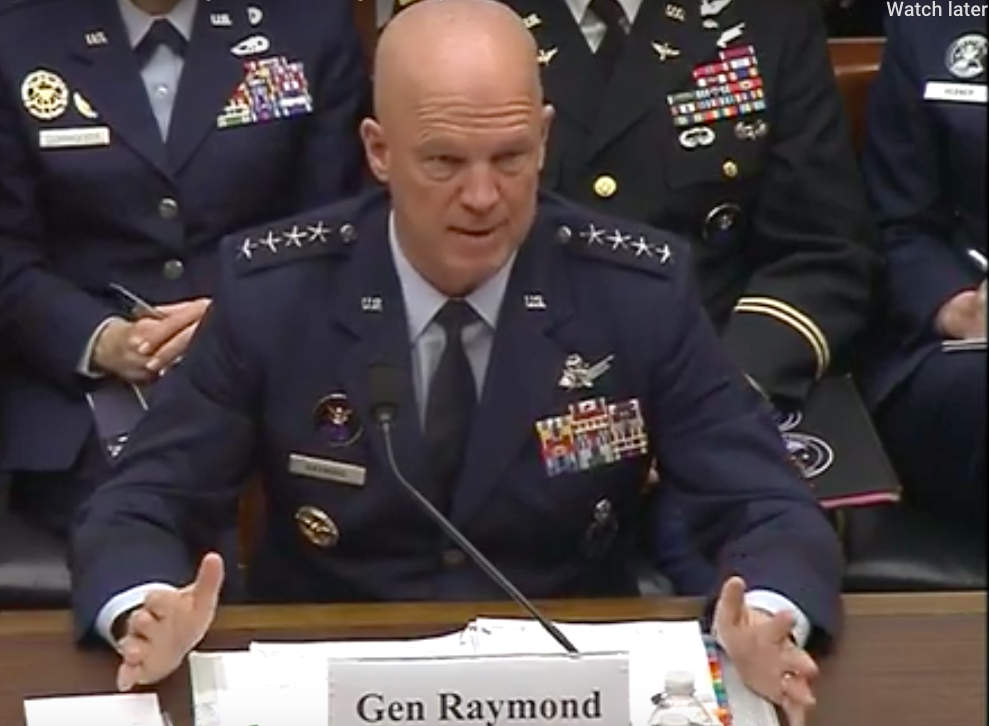
Gen. Jay Raymon testifies today to the HASC
CAPITOL HILL: The Space Force will wrap up a new space doctrine to reflect the increased threat to US assets from Russia and China “in the next couple of months,” Chief of Space Operations Gen. Jay Raymond told the House Armed Services Committee today.
Raymond, in his first budget hearing as head of the new service, said that US adversaries building counterspace capabilities to attack US satellites. This, he said, is why the Space Force is spearheading a “strong pivot toward space superiority. We had a space doctrine before, it was doctrine that was built for largely a benign domain,” Raymond said. “That’s not going to work today.”
Raymond was responding to a direct query from the HASC’s top Republican, Doug Lamborn, who pointed out that the new doctrine and operational concepts are needed to steer how the future space forces are organized and equipped.
Raymond said the Space Force is now putting the final touches on a “first draft capstone document” that will be followed by a series of sub-doctrine papers, as well as a new joint doctrine for space.
As Breaking D readers know, Raymond and company actually started thinking about new doctrine almost as soon as Space Command was created. Since then, the Air Force has been holding senior level meetings on doctrinal development, and as Maj. Gen. John Shaw, head of Space Force Operations Command, said earlier this year, they included Navy and Army representatives to consider what lessons might be learned from them.
Doctrine matters because it guides military forces on how to carry out policy and strategy decisions. The armed services each boast their own doctrine, and the Joint Chiefs of Staff staff put together joint doctrine that guides how the services work together and attempts to standardize terminology.
Current doctrine covering space operations will have to change if it is to characterize space as a warfighting domain and reflect new chains of command. The central doctrinal document today for space is Joint Doctrine 3-14, Space Operations, last updated in 2018. Perhaps one its most important functions is defining the types of space operations that can be undertaken and in what circumstances — such as space control.
One of the key doctrinal changes required, experts say, will be to define not just passive defense operations, but also so-called ‘active defense’ operations. What is meant by ‘active defense’ — and how it is different than offensive operations — has long been less than clear. Further, Air Force officials — including Raymond — have been perfectly clear that Space Command, supported by Space Force, will be undertaking offensive space missions in the future — something that the US military long has been loathe to admit in public.
While doctrine development is moving apace, the highly political choice of where to base Space Command headquarters is moving farther away. Air Force Secretary Barbara Barrett told HASC lawmakers that in part due to the personnel moves required by standing up Space Force headquarters here in Washington, the service has decided to re-start the process for finding Space Command a home.
“We’re going to reopen that process and put forward criteria in detail, and invite all who think they have a good shot at it come and represent their communities,” she said. Barrett said that the new process would be announced in spring, but a final basing decision would not be made until either late this year or early next year.
As Breaking D readers know, the original effort to assess possible sites for Space Command HQ began at the end of August with six bases in the running: Buckley AFB, Cheyenne Mountain AFB, Peterson AFB and Schriever AFB in Colorado; Vandenberg AFB in California, and Redstone Arsenal. One can assume the representative congressional delegations will be eager to re-up their bids.
Lawmakers also pushed the Air Force leadership on integrating National Guard and Reserve forces into the Space Force, sooner rather than later. Both Barrett and Raymond rushed to assure HASC members that there would be a guard and reserve component. Raymond noted that the Air Force is required under the 2020 National Defense Authorization Act to do a review of the process for this.
Even more so than their Senate counterparts yesterday, HASC members cracked the whip on the need to bring down maintenance costs of the F-35 Joint Strike Fighter.
While not the only lawmaker to do so, Rep. John Garamendi was the most forceful on the issue — pointedly saying that the Air Force cannot solve the problem by giving the long-troubled Autonomic Logistics Information System (ALIS) system a new name, referring to Lockheed Martin’s decision in January to reinvent its approach under an effort called Operational Data Integrated Network (ODIN).
“Heads up, we’re not going to back off on this,” he warned. “The spurs are on and we’re gonna ride this hard until it’s resolved.”
Air Force Chief of Staff Gen. David Goldfein assured him that “ALIS to ODIN is not just a name change,” adding that he has seen “more movement on the program over the last six months than in the last two years.”
Garamendi quipped back: “Well, I think Lockheed Martin is in the audience and they know they are in deep trouble, and so do you.” Hello, Fort Worth and Orlando!
Iran says it shot down Israel’s attack. Here’s what air defense systems it might have used.
Tehran has been increasingly public about its air defense capabilities, including showing off models of systems at a recent international defense expo.


























